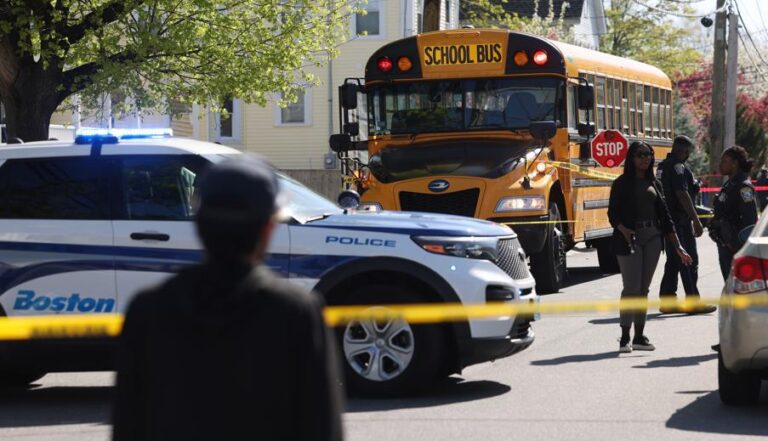Every day, more than 600 Boston Public Schools buses zigzag across the city to transport more than 22,000 children to and from hundreds of schools.
School choice, a legacy of Boston’s integration busing system that allows students to skip campuses closest to them in favor of another school they deem more desirable, means about half of students attend schools outside their neighborhoods. By state law, the district is also required to bus private and charter school students who live in the city.
Altogether, thousands of students sit on district buses for more than 45 minutes each morning as they are transported to far-flung neighborhoods they and their families have chosen.
The recent tragedy of a school bus striking and killing a 5-year-old has prompted questions about school bus safety and whether there are safer alternatives than to bus students across the city.
City officials recently said the district’s buses are involved in about 400 crashes per year, though most are minor. Across the state, 19 people died in school bus-involved crashes in the last decade; across the country, more than 100 die that way each year. More than a dozen personal injury claims have been filed against the transportation company Transdev, and its drivers, since it began operating BPS school buses in 2013, according to a Globe review of court data.
Still, experts say school buses remain one the safest modes of transportation to take students to and from school.
“They’re built for safety,’’ said Tom Hamilton, executive director of the School Transportation Association of Massachusetts. “They’re the safest method of commuting kids to and from school.’’
The American Academy of Pediatrics calculated school and other buses as having the lowest fatality rate of all modes of transportation to school, with passenger vehicles driven by teenage students accounting for the majority of fatalities.
A Globe review of state crash statistics agrees. From 2015 to 2024, there were 242 deaths on Boston’s streets, or about two per month, including nearly 100 pedestrians. Lens A. Joseph, the kindergartener who was struck and killed by the same bus he had just been on, was the only BPS bus rider to die in a crash since 2015. On a per-passenger-mile basis, riding a BPS school bus appears to have been substantially safer than other modes of transportation and much, much safer than walking.
Dr. Sadiqa Kendi, a Boston University pediatrician, noted that while school buses are relatively safe, they are more dangerous during pickup and drop-off — as with Lens.
“The most dangerous time for children is being around a school bus, not actually being on a school bus,’’ Kendi said. “When children are getting on and off the bus, communication is really important.’’
According to the National Highway Transit Administration, large school buses in particular are designed for safety, with rollover protection features, the ability to withstand significant impact levels, and seats designed to absorb energy during a crash.
The trend is clearer nationwide. According to a Globe analysis of national statistics, about 0.02 school bus riders die for every 100 million miles riders travel, compared with about 1.4 deaths per 100 million miles for all road users.
Walking and cycling carry a risk many times that of school buses, with dozens of deaths per 100 million miles. Even with the shorter distances that neighborhood schools would entail, walking to school would remain more dangerous than the current school bus-centric model.
Features like flashing red lights when students are getting on and off the bus add to their safety relative to parents driving their kids, Hamilton said. A recent state law also allows school buses to use cameras to catch people who pass them when the lights are flashing and the stop arm is extended, he noted.
Recent changes to Boston Public Schools’ school bus contract could make the district’s buses more dangerous: since 2023, the operator Transdev has faced penalties if too many buses are late or fail to show up. Chronically late buses are a longstanding complaint with the district, but pressure to avoid those penalties could be a problem as well.
Multiple Hyde Park residents at a recent community meeting following Lens’s death said they’ve witnessed BPS school buses speeding through their neighborhood and running stop signs. The city’s Boston 311, a public portal for residents to report complaints to city officials, also recently fielded repeated calls from residents across Boston who raised the same concerns.
In Massachusetts, school bus drivers must hold a commercial driver’s license, along with a passenger endorsement and a separate school bus driver certificate, and must complete up to 60 hours of preservice training from a certified bus instructor before they can get behind the wheel of a school bus, according to the state Registry of Motor Vehicles.
The driver in Boston’s recent crash had an expired school bus driver certificate. School bus driver certificates must be renewed each year, which requires a new criminal record background check, medical clearance, and proof of eight hours of “in-service training’’ conducted by an certified instructor.
“You have committed drivers, trained drivers, who go through some serious training,’’ said Hamilton, from the state transportation association.
BPS said it is strengthening safety protocols, increasing the frequency of regular meetings to now meet daily with Transdev safety leadership to review all crashes and safety incidents, as well as Transdev’s response to each one, Mayor Michelle Wu and Superintendent Mary Skipper said last month.
Transdev also is bringing in additional safety staff to accelerate regular refresher training of all drivers on pickup, drop-off, and crash protocols, according to Wu and Skipper.
Fatality data do not tell us how many people are being injured in BPS bus crashes, as the state crash data does not specify the bus operator. Court filings show at least 15 personal injury claims against Transdev since 2013, while state data indicate more than 100 nonfatal crashes involving school buses in Boston during that period overall.
It’s also unclear how many of the city’s other traffic fatalities were students traveling to and from school, although there were eight cyclists and pedestrians aged 20 and younger killed in the last decade. Around half the district’s students — more than 25,000 — already live within walking distance of their schools, according to district data. Nationally, no form of transportation is as dangerous overall as walking, with about 45 deaths last year per 100 million miles traveled.
Kendi, the pediatrician, emphasized walking is healthy for children, but families should ensure their children walk safely, following routes with sidewalks and crosswalks.
Thousands more BPS students ride the MBTA to school, as all students grade 7 and up get free T passes; transit, like school buses, appears to be much safer for riders than passenger cars.
Christopher Huffaker can be reached at christopher. huffaker@globe.com. Follow him @huffakingit.

